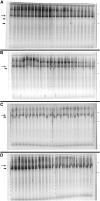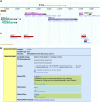large-scale screening for targeted knockouts in the Caenorhabditis elegans genome
- PMID: 23173093
- PMCID: PMC3484672
- DOI: 10.1534/g3.112.003830
large-scale screening for targeted knockouts in the Caenorhabditis elegans genome
Abstract
The nematode Caenorhabditis elegans is a powerful model system to study contemporary biological problems. This system would be even more useful if we had mutations in all the genes of this multicellular metazoan. The combined efforts of the C. elegans Deletion Mutant Consortium and individuals within the worm community are moving us ever closer to this goal. At present, of the 20,377 protein-coding genes in this organism, 6764 genes with associated molecular lesions are either deletions or null mutations (WormBase WS220). Our three laboratories have contributed the majority of mutated genes, 6841 mutations in 6013 genes. The principal method we used to detect deletion mutations in the nematode utilizes polymerase chain reaction (PCR). More recently, we have used array comparative genome hybridization (aCGH) to detect deletions across the entire coding part of the genome and massively parallel short-read sequencing to identify nonsense, splicing, and missense defects in open reading frames. As deletion strains can be frozen and then thawed when needed, these strains will be an enduring community resource. Our combined molecular screening strategies have improved the overall throughput of our gene-knockout facilities and have broadened the types of mutations that we and others can identify. These multiple strategies should enable us to eventually identify a mutation in every gene in this multicellular organism. This knowledge will usher in a new age of metazoan genetics in which the contribution to any biological process can be assessed for all genes.
Keywords: deletion mutations; genomics; knockouts; multi-gene families.
Figures



References
-
- Ambros V., 1997. Heterochronic genes, C. elegans II, Ed. 2, edited by Riddle D. L., Blumenthal T., Meyer B. J., Priess J. R. Cold Spring Harbor Laboratory Press, Cold Spring Harbor, NY - PubMed
-
- Ambros V., 2004. The functions of animal microRNAs. Nature 431: 350–355 - PubMed
-
- Antebi A., 2006. Nuclear hormone receptors in C. elegans (January 3, 2006), WormBook, ed. The C. elegans Research Community WormBook, /10.1895/wormbook.1.64.1, http://www.wormbook.org - PMC - PubMed
-
- Ashrafi K., Chang F. Y., Watts J. L., Fraser A. G., Kamath R. S., et al. , 2003. Genome-wide RNAi analysis of Caenorhabditis elegans fat regulatory genes. Nature 421: 268–272 - PubMed
Publication types
MeSH terms
Grants and funding
LinkOut - more resources
Full Text Sources
Other Literature Sources
Medical
Research Materials
